Managing and Coordinating the Human Resources Function
VerifiedAdded on 2022/12/22
|17
|5442
|50
AI Summary
This report explores the objectives, theories, and functions of human resource management in organizations. It discusses the role of HR in delivering organizational objectives, different ways HR objectives are delivered, and HR functions in different sectors and sizes of organizations. It also examines two major theories of change management and methods for evaluating HR functions. The report provides examples and strategies for effective HR management.
Contribute Materials
Your contribution can guide someone’s learning journey. Share your
documents today.
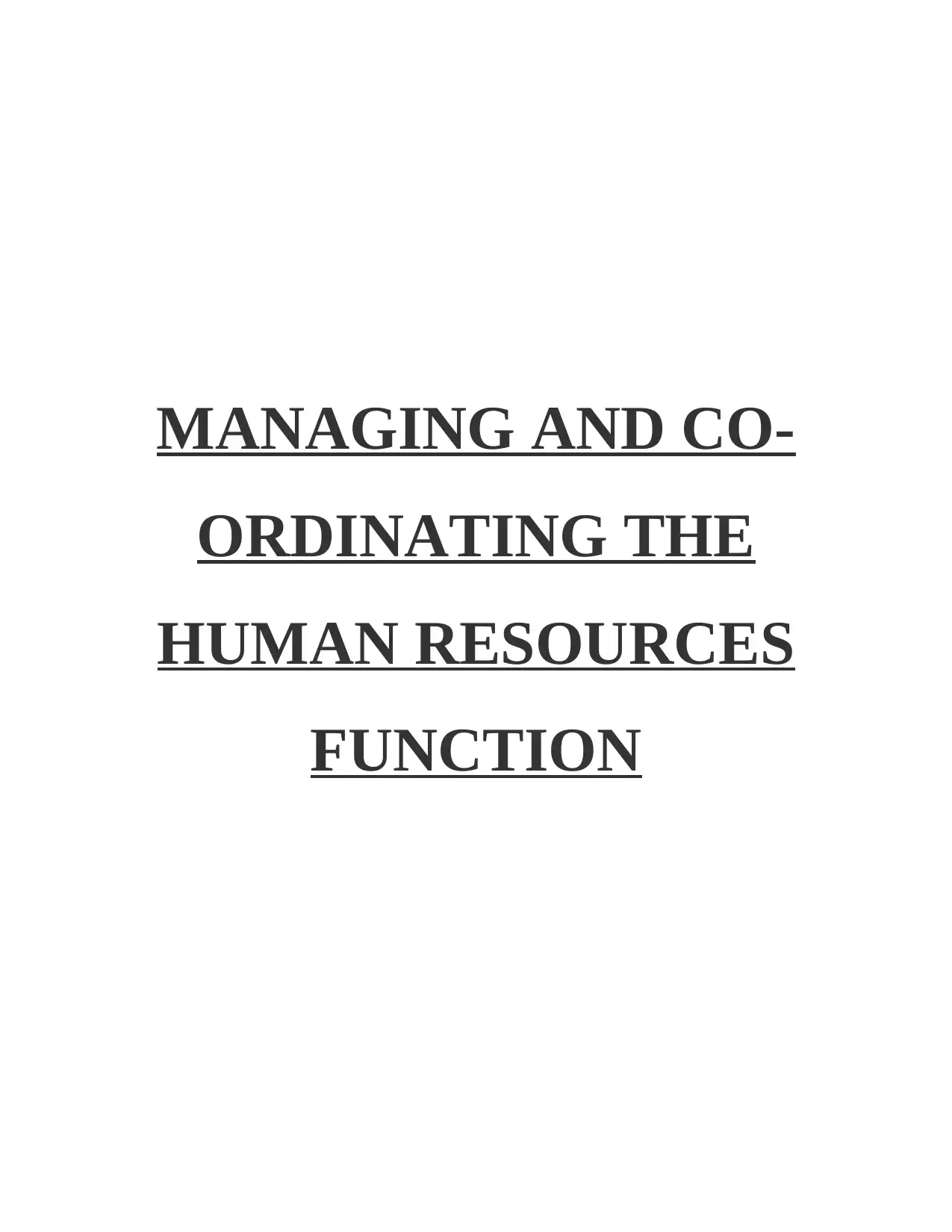
MANAGING AND CO-
ORDINATING THE
HUMAN RESOURCES
FUNCTION
ORDINATING THE
HUMAN RESOURCES
FUNCTION
Secure Best Marks with AI Grader
Need help grading? Try our AI Grader for instant feedback on your assignments.
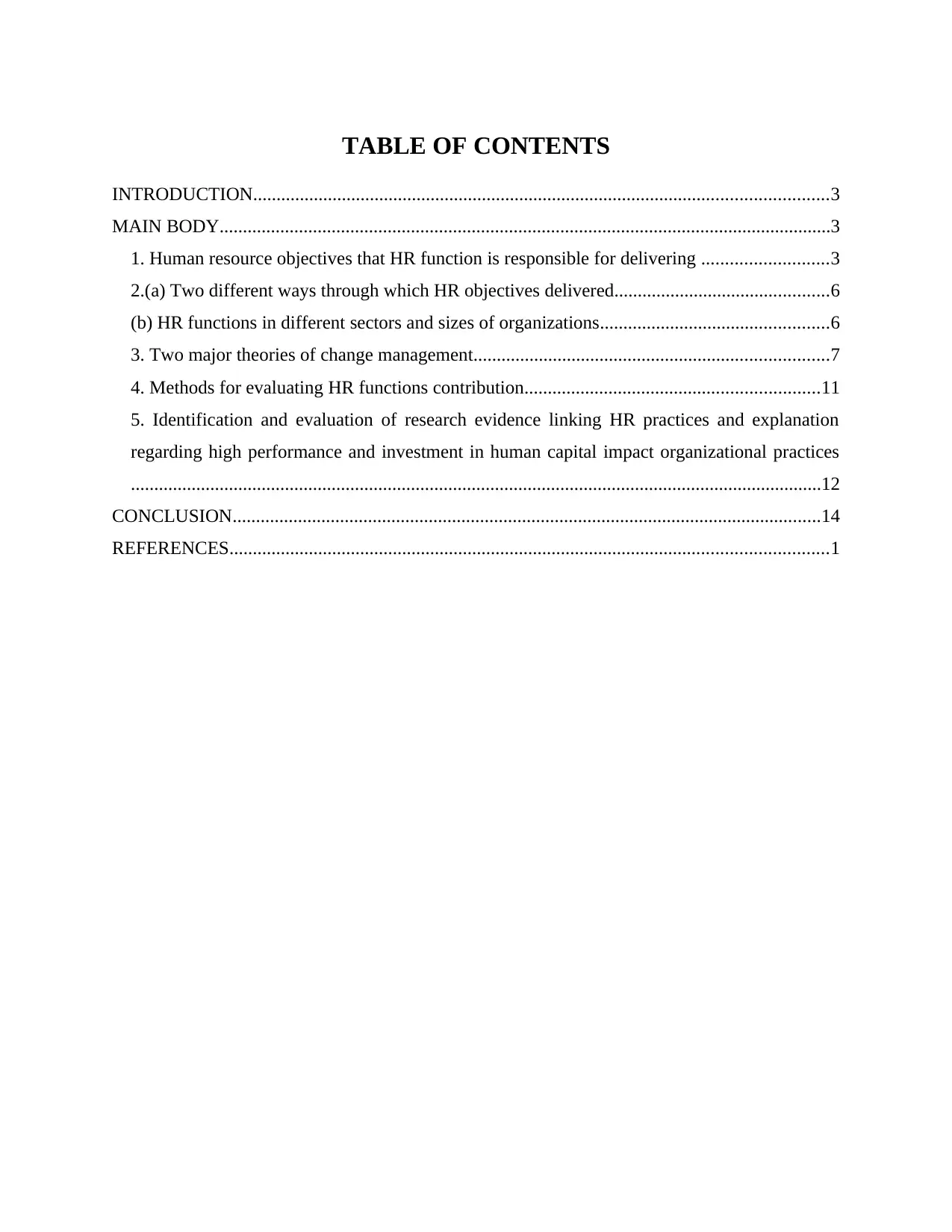
TABLE OF CONTENTS
INTRODUCTION...........................................................................................................................3
MAIN BODY...................................................................................................................................3
1. Human resource objectives that HR function is responsible for delivering ...........................3
2.(a) Two different ways through which HR objectives delivered..............................................6
(b) HR functions in different sectors and sizes of organizations.................................................6
3. Two major theories of change management............................................................................7
4. Methods for evaluating HR functions contribution...............................................................11
5. Identification and evaluation of research evidence linking HR practices and explanation
regarding high performance and investment in human capital impact organizational practices
....................................................................................................................................................12
CONCLUSION..............................................................................................................................14
REFERENCES................................................................................................................................1
INTRODUCTION...........................................................................................................................3
MAIN BODY...................................................................................................................................3
1. Human resource objectives that HR function is responsible for delivering ...........................3
2.(a) Two different ways through which HR objectives delivered..............................................6
(b) HR functions in different sectors and sizes of organizations.................................................6
3. Two major theories of change management............................................................................7
4. Methods for evaluating HR functions contribution...............................................................11
5. Identification and evaluation of research evidence linking HR practices and explanation
regarding high performance and investment in human capital impact organizational practices
....................................................................................................................................................12
CONCLUSION..............................................................................................................................14
REFERENCES................................................................................................................................1

INTRODUCTION
Human resource is a group of people who are responsible for the workforce within the
organization, industry, business sector and economy as well. It consists of various functions
including planning, organizing, directing, controlling, finding, recruiting, showing, etc. of
selected as well as existing candidates in order to enhance their productivity and thus overall
enterprise (Glaister, 2020). For efficient functioning of human resource people, human resource
management ensure their strategic approach expeditiously in an organization in a way in which
they provide help into business gains a competitive advantage. It must be designed in a manner
in which they can maximize their employees performance as a whole.
This report will describe the human resource functions in detail along with different
company examples, human resource objectives, change management theories with their usage in
different organization. Apart from this, the study will also highlight the concept of criteria and
methods to use human resource functions and their linkage with positive organizational
outcomes.
MAIN BODY
1. Human resource objectives that HR function is responsible for delivering
Human resource management is a kind of administration of human resources within the
company. Their primary role is to handle the employees and identify their requirements in order
to maintain a positive working environment. There are various objectives of human resource
people which ensures seamless experiences for their employees and other associated people who
help to achieve organizational goals (Schuler, 2020). Through the enforcement of objectives of
HR department they ensure the availability of resources efficiently, easily able to access the data,
ensure compliances, etc. The objectives majorly influenced by company goals and must ensures
a stable work force and efficient operations. Below are the human resource major objectives in
context of company examples are: Organization designing: The basic and foremost role of human resource management is
design the job according to its needs and requirements along with the integration of
overall enterprise in order to ensure the operations of the whole organization in one
direction which provides the working in order to achieve their pre-defined goals and
objectives. To achieve this the HR managers within an organization have to focus on both
Human resource is a group of people who are responsible for the workforce within the
organization, industry, business sector and economy as well. It consists of various functions
including planning, organizing, directing, controlling, finding, recruiting, showing, etc. of
selected as well as existing candidates in order to enhance their productivity and thus overall
enterprise (Glaister, 2020). For efficient functioning of human resource people, human resource
management ensure their strategic approach expeditiously in an organization in a way in which
they provide help into business gains a competitive advantage. It must be designed in a manner
in which they can maximize their employees performance as a whole.
This report will describe the human resource functions in detail along with different
company examples, human resource objectives, change management theories with their usage in
different organization. Apart from this, the study will also highlight the concept of criteria and
methods to use human resource functions and their linkage with positive organizational
outcomes.
MAIN BODY
1. Human resource objectives that HR function is responsible for delivering
Human resource management is a kind of administration of human resources within the
company. Their primary role is to handle the employees and identify their requirements in order
to maintain a positive working environment. There are various objectives of human resource
people which ensures seamless experiences for their employees and other associated people who
help to achieve organizational goals (Schuler, 2020). Through the enforcement of objectives of
HR department they ensure the availability of resources efficiently, easily able to access the data,
ensure compliances, etc. The objectives majorly influenced by company goals and must ensures
a stable work force and efficient operations. Below are the human resource major objectives in
context of company examples are: Organization designing: The basic and foremost role of human resource management is
design the job according to its needs and requirements along with the integration of
overall enterprise in order to ensure the operations of the whole organization in one
direction which provides the working in order to achieve their pre-defined goals and
objectives. To achieve this the HR managers within an organization have to focus on both
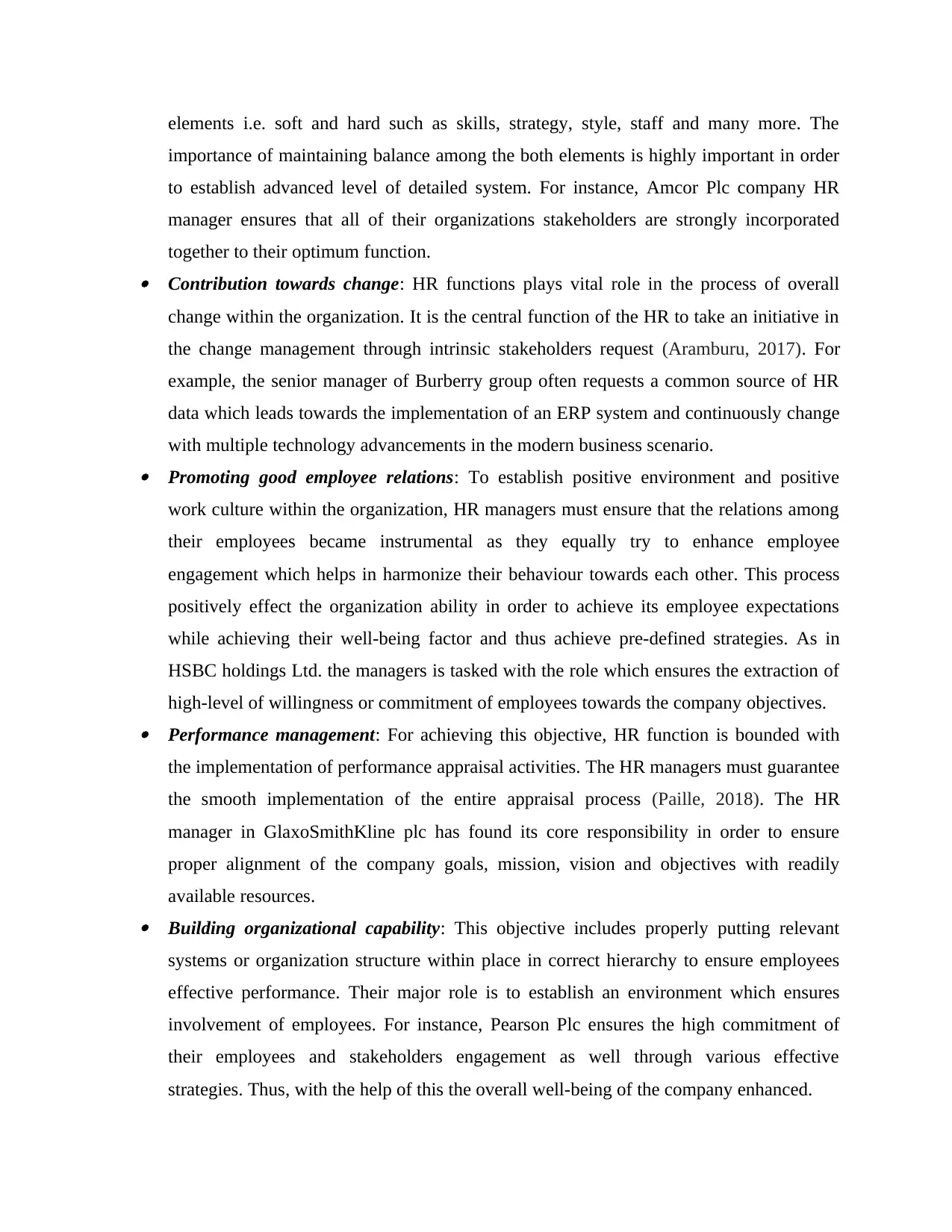
elements i.e. soft and hard such as skills, strategy, style, staff and many more. The
importance of maintaining balance among the both elements is highly important in order
to establish advanced level of detailed system. For instance, Amcor Plc company HR
manager ensures that all of their organizations stakeholders are strongly incorporated
together to their optimum function. Contribution towards change: HR functions plays vital role in the process of overall
change within the organization. It is the central function of the HR to take an initiative in
the change management through intrinsic stakeholders request (Aramburu, 2017). For
example, the senior manager of Burberry group often requests a common source of HR
data which leads towards the implementation of an ERP system and continuously change
with multiple technology advancements in the modern business scenario. Promoting good employee relations: To establish positive environment and positive
work culture within the organization, HR managers must ensure that the relations among
their employees became instrumental as they equally try to enhance employee
engagement which helps in harmonize their behaviour towards each other. This process
positively effect the organization ability in order to achieve its employee expectations
while achieving their well-being factor and thus achieve pre-defined strategies. As in
HSBC holdings Ltd. the managers is tasked with the role which ensures the extraction of
high-level of willingness or commitment of employees towards the company objectives. Performance management: For achieving this objective, HR function is bounded with
the implementation of performance appraisal activities. The HR managers must guarantee
the smooth implementation of the entire appraisal process (Paille, 2018). The HR
manager in GlaxoSmithKline plc has found its core responsibility in order to ensure
proper alignment of the company goals, mission, vision and objectives with readily
available resources. Building organizational capability: This objective includes properly putting relevant
systems or organization structure within place in correct hierarchy to ensure employees
effective performance. Their major role is to establish an environment which ensures
involvement of employees. For instance, Pearson Plc ensures the high commitment of
their employees and stakeholders engagement as well through various effective
strategies. Thus, with the help of this the overall well-being of the company enhanced.
importance of maintaining balance among the both elements is highly important in order
to establish advanced level of detailed system. For instance, Amcor Plc company HR
manager ensures that all of their organizations stakeholders are strongly incorporated
together to their optimum function. Contribution towards change: HR functions plays vital role in the process of overall
change within the organization. It is the central function of the HR to take an initiative in
the change management through intrinsic stakeholders request (Aramburu, 2017). For
example, the senior manager of Burberry group often requests a common source of HR
data which leads towards the implementation of an ERP system and continuously change
with multiple technology advancements in the modern business scenario. Promoting good employee relations: To establish positive environment and positive
work culture within the organization, HR managers must ensure that the relations among
their employees became instrumental as they equally try to enhance employee
engagement which helps in harmonize their behaviour towards each other. This process
positively effect the organization ability in order to achieve its employee expectations
while achieving their well-being factor and thus achieve pre-defined strategies. As in
HSBC holdings Ltd. the managers is tasked with the role which ensures the extraction of
high-level of willingness or commitment of employees towards the company objectives. Performance management: For achieving this objective, HR function is bounded with
the implementation of performance appraisal activities. The HR managers must guarantee
the smooth implementation of the entire appraisal process (Paille, 2018). The HR
manager in GlaxoSmithKline plc has found its core responsibility in order to ensure
proper alignment of the company goals, mission, vision and objectives with readily
available resources. Building organizational capability: This objective includes properly putting relevant
systems or organization structure within place in correct hierarchy to ensure employees
effective performance. Their major role is to establish an environment which ensures
involvement of employees. For instance, Pearson Plc ensures the high commitment of
their employees and stakeholders engagement as well through various effective
strategies. Thus, with the help of this the overall well-being of the company enhanced.
Secure Best Marks with AI Grader
Need help grading? Try our AI Grader for instant feedback on your assignments.
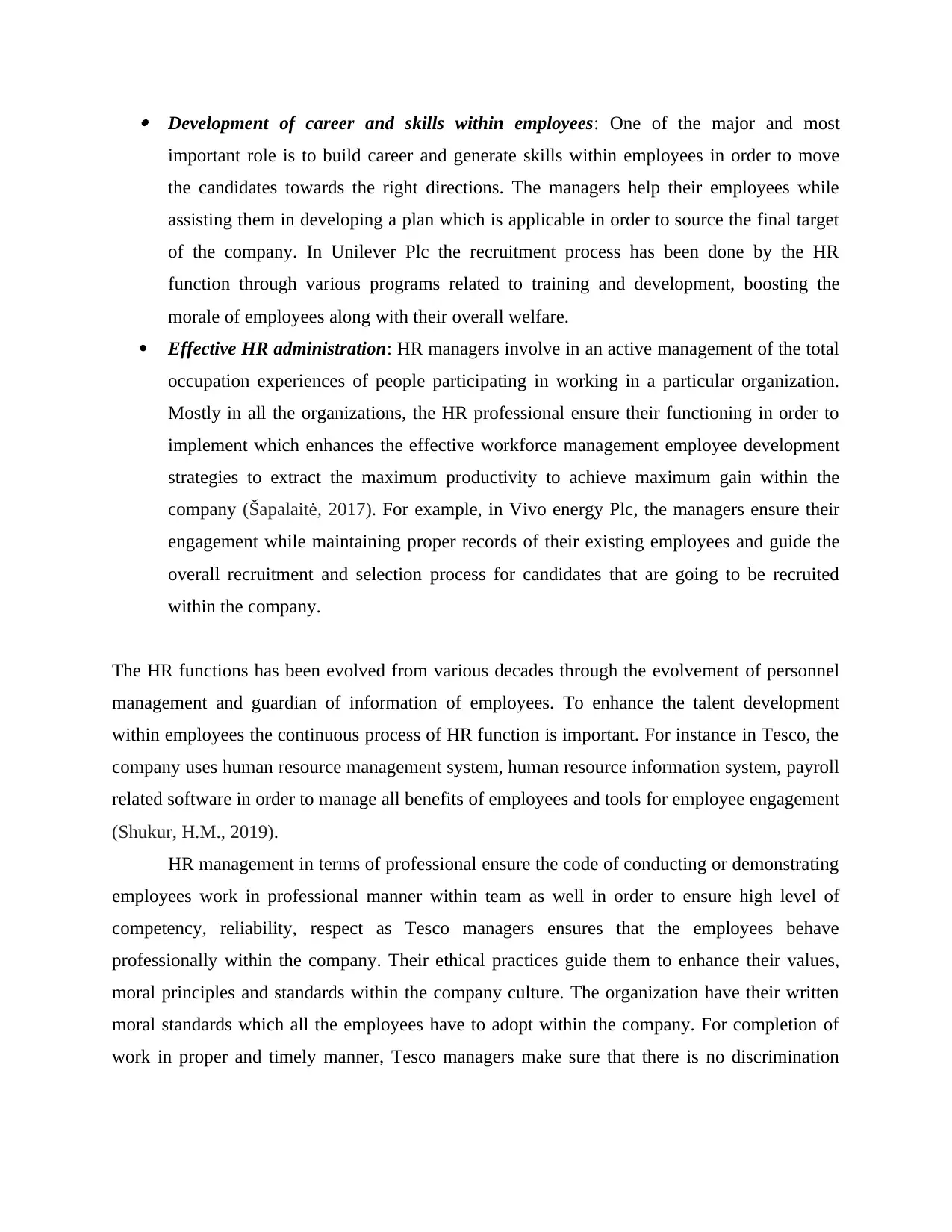
Development of career and skills within employees: One of the major and most
important role is to build career and generate skills within employees in order to move
the candidates towards the right directions. The managers help their employees while
assisting them in developing a plan which is applicable in order to source the final target
of the company. In Unilever Plc the recruitment process has been done by the HR
function through various programs related to training and development, boosting the
morale of employees along with their overall welfare.
Effective HR administration: HR managers involve in an active management of the total
occupation experiences of people participating in working in a particular organization.
Mostly in all the organizations, the HR professional ensure their functioning in order to
implement which enhances the effective workforce management employee development
strategies to extract the maximum productivity to achieve maximum gain within the
company (Šapalaitė, 2017). For example, in Vivo energy Plc, the managers ensure their
engagement while maintaining proper records of their existing employees and guide the
overall recruitment and selection process for candidates that are going to be recruited
within the company.
The HR functions has been evolved from various decades through the evolvement of personnel
management and guardian of information of employees. To enhance the talent development
within employees the continuous process of HR function is important. For instance in Tesco, the
company uses human resource management system, human resource information system, payroll
related software in order to manage all benefits of employees and tools for employee engagement
(Shukur, H.M., 2019).
HR management in terms of professional ensure the code of conducting or demonstrating
employees work in professional manner within team as well in order to ensure high level of
competency, reliability, respect as Tesco managers ensures that the employees behave
professionally within the company. Their ethical practices guide them to enhance their values,
moral principles and standards within the company culture. The organization have their written
moral standards which all the employees have to adopt within the company. For completion of
work in proper and timely manner, Tesco managers make sure that there is no discrimination
important role is to build career and generate skills within employees in order to move
the candidates towards the right directions. The managers help their employees while
assisting them in developing a plan which is applicable in order to source the final target
of the company. In Unilever Plc the recruitment process has been done by the HR
function through various programs related to training and development, boosting the
morale of employees along with their overall welfare.
Effective HR administration: HR managers involve in an active management of the total
occupation experiences of people participating in working in a particular organization.
Mostly in all the organizations, the HR professional ensure their functioning in order to
implement which enhances the effective workforce management employee development
strategies to extract the maximum productivity to achieve maximum gain within the
company (Šapalaitė, 2017). For example, in Vivo energy Plc, the managers ensure their
engagement while maintaining proper records of their existing employees and guide the
overall recruitment and selection process for candidates that are going to be recruited
within the company.
The HR functions has been evolved from various decades through the evolvement of personnel
management and guardian of information of employees. To enhance the talent development
within employees the continuous process of HR function is important. For instance in Tesco, the
company uses human resource management system, human resource information system, payroll
related software in order to manage all benefits of employees and tools for employee engagement
(Shukur, H.M., 2019).
HR management in terms of professional ensure the code of conducting or demonstrating
employees work in professional manner within team as well in order to ensure high level of
competency, reliability, respect as Tesco managers ensures that the employees behave
professionally within the company. Their ethical practices guide them to enhance their values,
moral principles and standards within the company culture. The organization have their written
moral standards which all the employees have to adopt within the company. For completion of
work in proper and timely manner, Tesco managers make sure that there is no discrimination
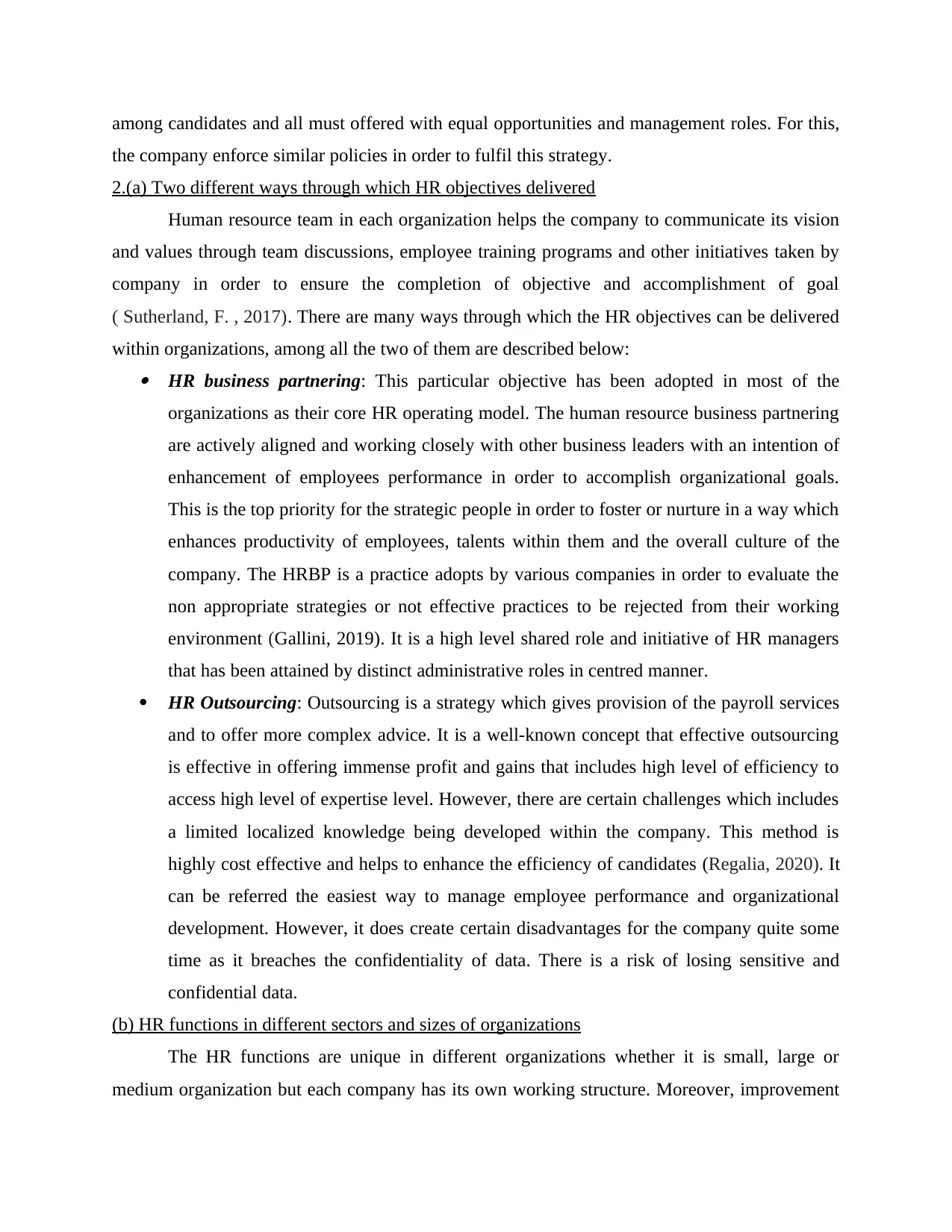
among candidates and all must offered with equal opportunities and management roles. For this,
the company enforce similar policies in order to fulfil this strategy.
2.(a) Two different ways through which HR objectives delivered
Human resource team in each organization helps the company to communicate its vision
and values through team discussions, employee training programs and other initiatives taken by
company in order to ensure the completion of objective and accomplishment of goal
( Sutherland, F. , 2017). There are many ways through which the HR objectives can be delivered
within organizations, among all the two of them are described below: HR business partnering: This particular objective has been adopted in most of the
organizations as their core HR operating model. The human resource business partnering
are actively aligned and working closely with other business leaders with an intention of
enhancement of employees performance in order to accomplish organizational goals.
This is the top priority for the strategic people in order to foster or nurture in a way which
enhances productivity of employees, talents within them and the overall culture of the
company. The HRBP is a practice adopts by various companies in order to evaluate the
non appropriate strategies or not effective practices to be rejected from their working
environment (Gallini, 2019). It is a high level shared role and initiative of HR managers
that has been attained by distinct administrative roles in centred manner.
HR Outsourcing: Outsourcing is a strategy which gives provision of the payroll services
and to offer more complex advice. It is a well-known concept that effective outsourcing
is effective in offering immense profit and gains that includes high level of efficiency to
access high level of expertise level. However, there are certain challenges which includes
a limited localized knowledge being developed within the company. This method is
highly cost effective and helps to enhance the efficiency of candidates (Regalia, 2020). It
can be referred the easiest way to manage employee performance and organizational
development. However, it does create certain disadvantages for the company quite some
time as it breaches the confidentiality of data. There is a risk of losing sensitive and
confidential data.
(b) HR functions in different sectors and sizes of organizations
The HR functions are unique in different organizations whether it is small, large or
medium organization but each company has its own working structure. Moreover, improvement
the company enforce similar policies in order to fulfil this strategy.
2.(a) Two different ways through which HR objectives delivered
Human resource team in each organization helps the company to communicate its vision
and values through team discussions, employee training programs and other initiatives taken by
company in order to ensure the completion of objective and accomplishment of goal
( Sutherland, F. , 2017). There are many ways through which the HR objectives can be delivered
within organizations, among all the two of them are described below: HR business partnering: This particular objective has been adopted in most of the
organizations as their core HR operating model. The human resource business partnering
are actively aligned and working closely with other business leaders with an intention of
enhancement of employees performance in order to accomplish organizational goals.
This is the top priority for the strategic people in order to foster or nurture in a way which
enhances productivity of employees, talents within them and the overall culture of the
company. The HRBP is a practice adopts by various companies in order to evaluate the
non appropriate strategies or not effective practices to be rejected from their working
environment (Gallini, 2019). It is a high level shared role and initiative of HR managers
that has been attained by distinct administrative roles in centred manner.
HR Outsourcing: Outsourcing is a strategy which gives provision of the payroll services
and to offer more complex advice. It is a well-known concept that effective outsourcing
is effective in offering immense profit and gains that includes high level of efficiency to
access high level of expertise level. However, there are certain challenges which includes
a limited localized knowledge being developed within the company. This method is
highly cost effective and helps to enhance the efficiency of candidates (Regalia, 2020). It
can be referred the easiest way to manage employee performance and organizational
development. However, it does create certain disadvantages for the company quite some
time as it breaches the confidentiality of data. There is a risk of losing sensitive and
confidential data.
(b) HR functions in different sectors and sizes of organizations
The HR functions are unique in different organizations whether it is small, large or
medium organization but each company has its own working structure. Moreover, improvement
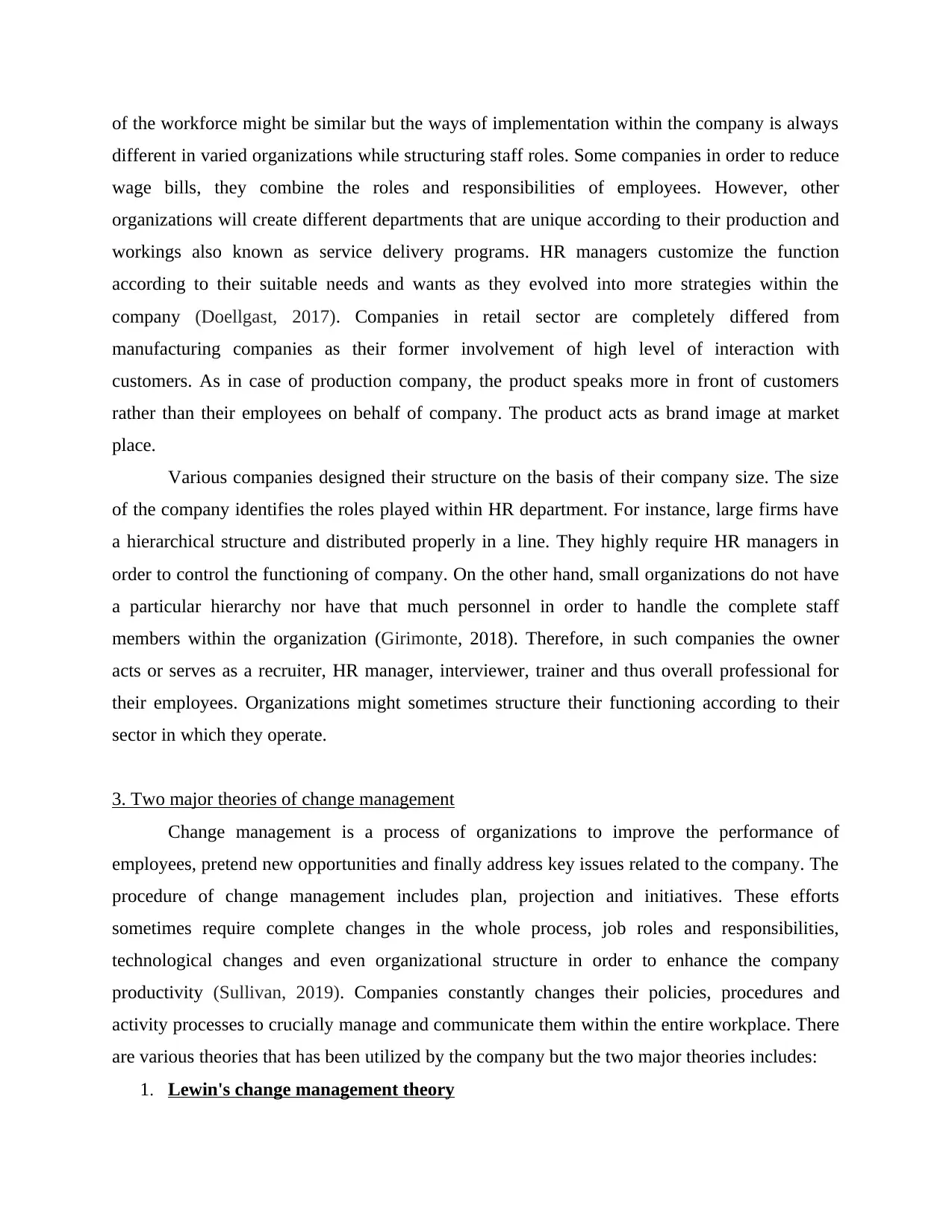
of the workforce might be similar but the ways of implementation within the company is always
different in varied organizations while structuring staff roles. Some companies in order to reduce
wage bills, they combine the roles and responsibilities of employees. However, other
organizations will create different departments that are unique according to their production and
workings also known as service delivery programs. HR managers customize the function
according to their suitable needs and wants as they evolved into more strategies within the
company (Doellgast, 2017). Companies in retail sector are completely differed from
manufacturing companies as their former involvement of high level of interaction with
customers. As in case of production company, the product speaks more in front of customers
rather than their employees on behalf of company. The product acts as brand image at market
place.
Various companies designed their structure on the basis of their company size. The size
of the company identifies the roles played within HR department. For instance, large firms have
a hierarchical structure and distributed properly in a line. They highly require HR managers in
order to control the functioning of company. On the other hand, small organizations do not have
a particular hierarchy nor have that much personnel in order to handle the complete staff
members within the organization (Girimonte, 2018). Therefore, in such companies the owner
acts or serves as a recruiter, HR manager, interviewer, trainer and thus overall professional for
their employees. Organizations might sometimes structure their functioning according to their
sector in which they operate.
3. Two major theories of change management
Change management is a process of organizations to improve the performance of
employees, pretend new opportunities and finally address key issues related to the company. The
procedure of change management includes plan, projection and initiatives. These efforts
sometimes require complete changes in the whole process, job roles and responsibilities,
technological changes and even organizational structure in order to enhance the company
productivity (Sullivan, 2019). Companies constantly changes their policies, procedures and
activity processes to crucially manage and communicate them within the entire workplace. There
are various theories that has been utilized by the company but the two major theories includes:
1. Lewin's change management theory
different in varied organizations while structuring staff roles. Some companies in order to reduce
wage bills, they combine the roles and responsibilities of employees. However, other
organizations will create different departments that are unique according to their production and
workings also known as service delivery programs. HR managers customize the function
according to their suitable needs and wants as they evolved into more strategies within the
company (Doellgast, 2017). Companies in retail sector are completely differed from
manufacturing companies as their former involvement of high level of interaction with
customers. As in case of production company, the product speaks more in front of customers
rather than their employees on behalf of company. The product acts as brand image at market
place.
Various companies designed their structure on the basis of their company size. The size
of the company identifies the roles played within HR department. For instance, large firms have
a hierarchical structure and distributed properly in a line. They highly require HR managers in
order to control the functioning of company. On the other hand, small organizations do not have
a particular hierarchy nor have that much personnel in order to handle the complete staff
members within the organization (Girimonte, 2018). Therefore, in such companies the owner
acts or serves as a recruiter, HR manager, interviewer, trainer and thus overall professional for
their employees. Organizations might sometimes structure their functioning according to their
sector in which they operate.
3. Two major theories of change management
Change management is a process of organizations to improve the performance of
employees, pretend new opportunities and finally address key issues related to the company. The
procedure of change management includes plan, projection and initiatives. These efforts
sometimes require complete changes in the whole process, job roles and responsibilities,
technological changes and even organizational structure in order to enhance the company
productivity (Sullivan, 2019). Companies constantly changes their policies, procedures and
activity processes to crucially manage and communicate them within the entire workplace. There
are various theories that has been utilized by the company but the two major theories includes:
1. Lewin's change management theory
Paraphrase This Document
Need a fresh take? Get an instant paraphrase of this document with our AI Paraphraser
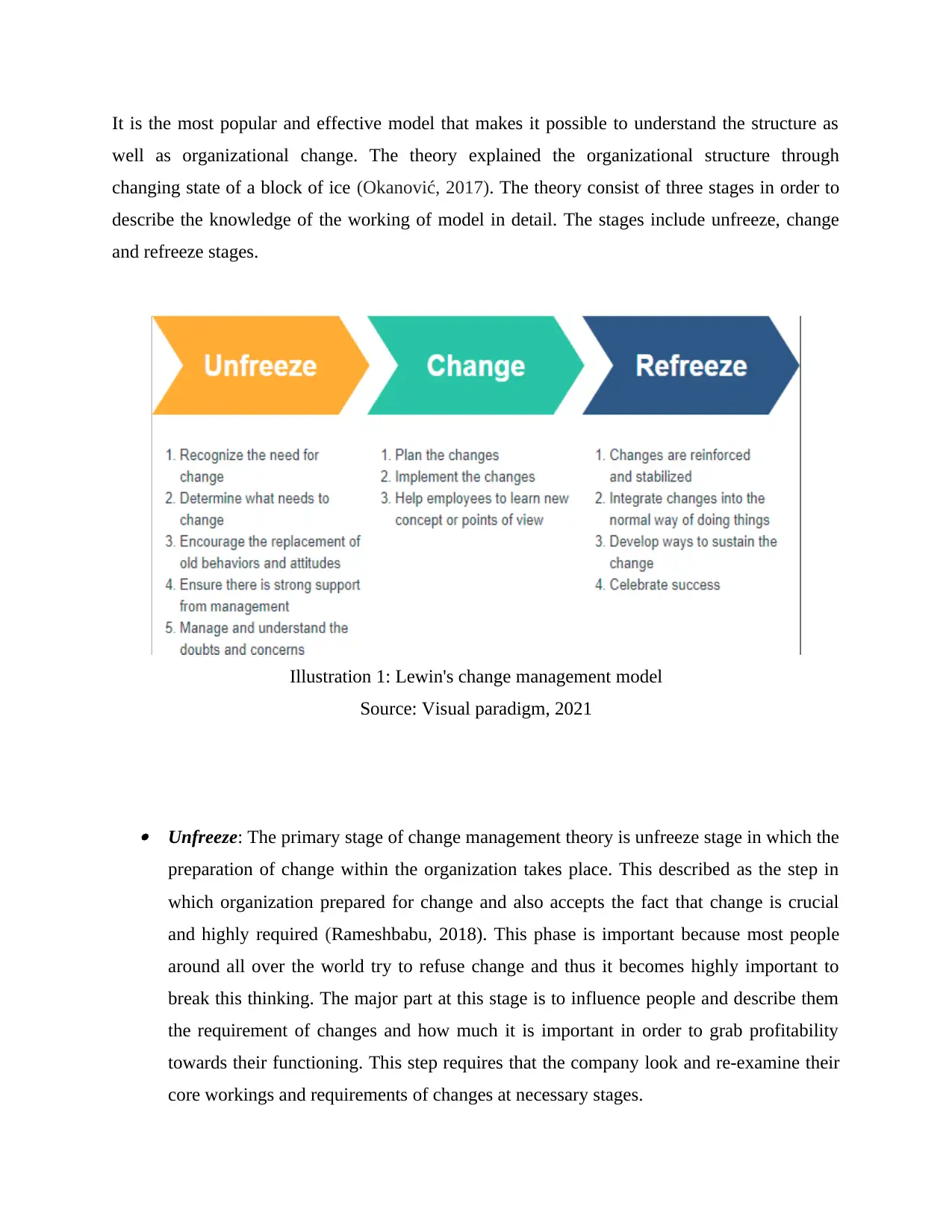
It is the most popular and effective model that makes it possible to understand the structure as
well as organizational change. The theory explained the organizational structure through
changing state of a block of ice (Okanović, 2017). The theory consist of three stages in order to
describe the knowledge of the working of model in detail. The stages include unfreeze, change
and refreeze stages.
Unfreeze: The primary stage of change management theory is unfreeze stage in which the
preparation of change within the organization takes place. This described as the step in
which organization prepared for change and also accepts the fact that change is crucial
and highly required (Rameshbabu, 2018). This phase is important because most people
around all over the world try to refuse change and thus it becomes highly important to
break this thinking. The major part at this stage is to influence people and describe them
the requirement of changes and how much it is important in order to grab profitability
towards their functioning. This step requires that the company look and re-examine their
core workings and requirements of changes at necessary stages.
Illustration 1: Lewin's change management model
Source: Visual paradigm, 2021
well as organizational change. The theory explained the organizational structure through
changing state of a block of ice (Okanović, 2017). The theory consist of three stages in order to
describe the knowledge of the working of model in detail. The stages include unfreeze, change
and refreeze stages.
Unfreeze: The primary stage of change management theory is unfreeze stage in which the
preparation of change within the organization takes place. This described as the step in
which organization prepared for change and also accepts the fact that change is crucial
and highly required (Rameshbabu, 2018). This phase is important because most people
around all over the world try to refuse change and thus it becomes highly important to
break this thinking. The major part at this stage is to influence people and describe them
the requirement of changes and how much it is important in order to grab profitability
towards their functioning. This step requires that the company look and re-examine their
core workings and requirements of changes at necessary stages.
Illustration 1: Lewin's change management model
Source: Visual paradigm, 2021
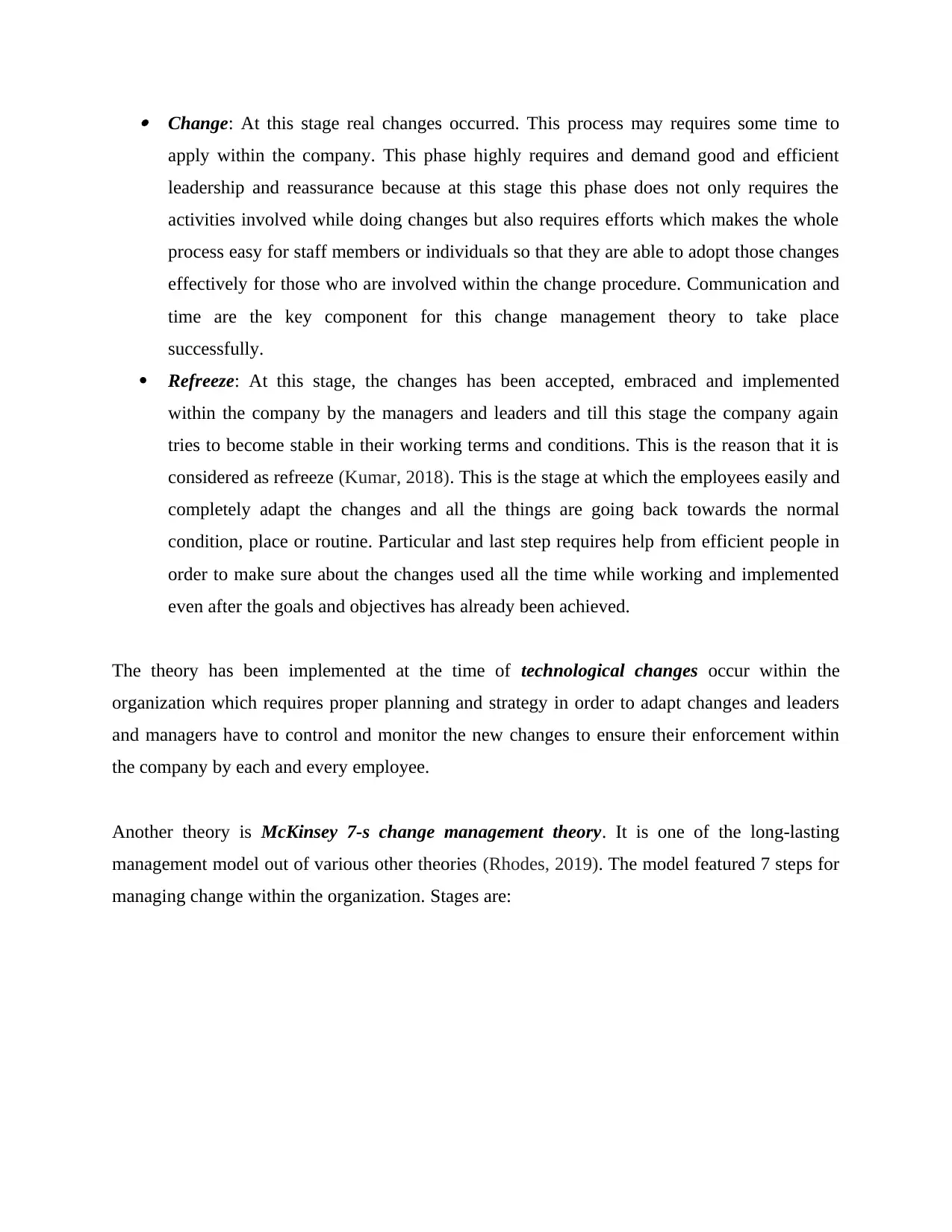
Change: At this stage real changes occurred. This process may requires some time to
apply within the company. This phase highly requires and demand good and efficient
leadership and reassurance because at this stage this phase does not only requires the
activities involved while doing changes but also requires efforts which makes the whole
process easy for staff members or individuals so that they are able to adopt those changes
effectively for those who are involved within the change procedure. Communication and
time are the key component for this change management theory to take place
successfully.
Refreeze: At this stage, the changes has been accepted, embraced and implemented
within the company by the managers and leaders and till this stage the company again
tries to become stable in their working terms and conditions. This is the reason that it is
considered as refreeze (Kumar, 2018). This is the stage at which the employees easily and
completely adapt the changes and all the things are going back towards the normal
condition, place or routine. Particular and last step requires help from efficient people in
order to make sure about the changes used all the time while working and implemented
even after the goals and objectives has already been achieved.
The theory has been implemented at the time of technological changes occur within the
organization which requires proper planning and strategy in order to adapt changes and leaders
and managers have to control and monitor the new changes to ensure their enforcement within
the company by each and every employee.
Another theory is McKinsey 7-s change management theory. It is one of the long-lasting
management model out of various other theories (Rhodes, 2019). The model featured 7 steps for
managing change within the organization. Stages are:
apply within the company. This phase highly requires and demand good and efficient
leadership and reassurance because at this stage this phase does not only requires the
activities involved while doing changes but also requires efforts which makes the whole
process easy for staff members or individuals so that they are able to adopt those changes
effectively for those who are involved within the change procedure. Communication and
time are the key component for this change management theory to take place
successfully.
Refreeze: At this stage, the changes has been accepted, embraced and implemented
within the company by the managers and leaders and till this stage the company again
tries to become stable in their working terms and conditions. This is the reason that it is
considered as refreeze (Kumar, 2018). This is the stage at which the employees easily and
completely adapt the changes and all the things are going back towards the normal
condition, place or routine. Particular and last step requires help from efficient people in
order to make sure about the changes used all the time while working and implemented
even after the goals and objectives has already been achieved.
The theory has been implemented at the time of technological changes occur within the
organization which requires proper planning and strategy in order to adapt changes and leaders
and managers have to control and monitor the new changes to ensure their enforcement within
the company by each and every employee.
Another theory is McKinsey 7-s change management theory. It is one of the long-lasting
management model out of various other theories (Rhodes, 2019). The model featured 7 steps for
managing change within the organization. Stages are:
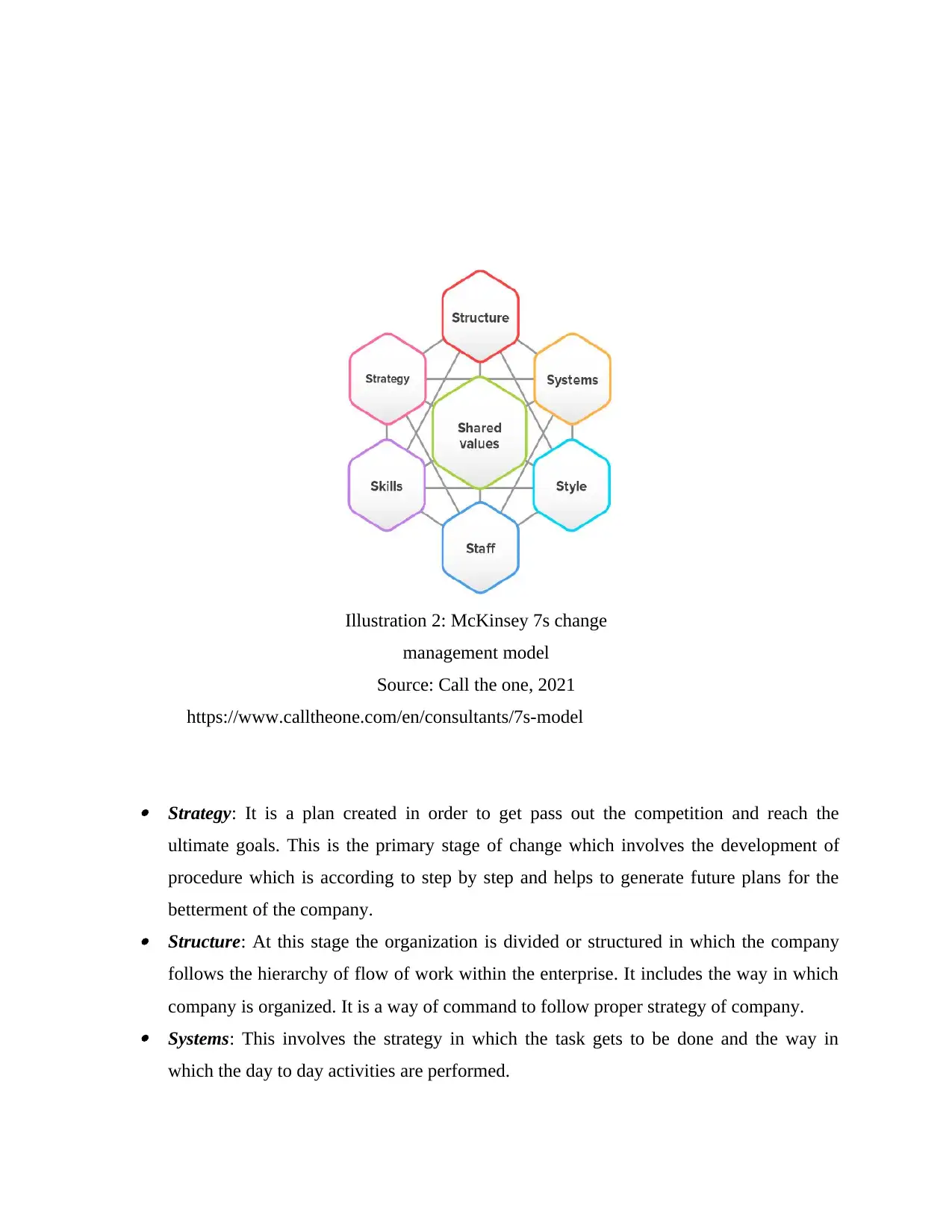
Strategy: It is a plan created in order to get pass out the competition and reach the
ultimate goals. This is the primary stage of change which involves the development of
procedure which is according to step by step and helps to generate future plans for the
betterment of the company. Structure: At this stage the organization is divided or structured in which the company
follows the hierarchy of flow of work within the enterprise. It includes the way in which
company is organized. It is a way of command to follow proper strategy of company. Systems: This involves the strategy in which the task gets to be done and the way in
which the day to day activities are performed.
Illustration 2: McKinsey 7s change
management model
Source: Call the one, 2021
https://www.calltheone.com/en/consultants/7s-model
ultimate goals. This is the primary stage of change which involves the development of
procedure which is according to step by step and helps to generate future plans for the
betterment of the company. Structure: At this stage the organization is divided or structured in which the company
follows the hierarchy of flow of work within the enterprise. It includes the way in which
company is organized. It is a way of command to follow proper strategy of company. Systems: This involves the strategy in which the task gets to be done and the way in
which the day to day activities are performed.
Illustration 2: McKinsey 7s change
management model
Source: Call the one, 2021
https://www.calltheone.com/en/consultants/7s-model
Secure Best Marks with AI Grader
Need help grading? Try our AI Grader for instant feedback on your assignments.
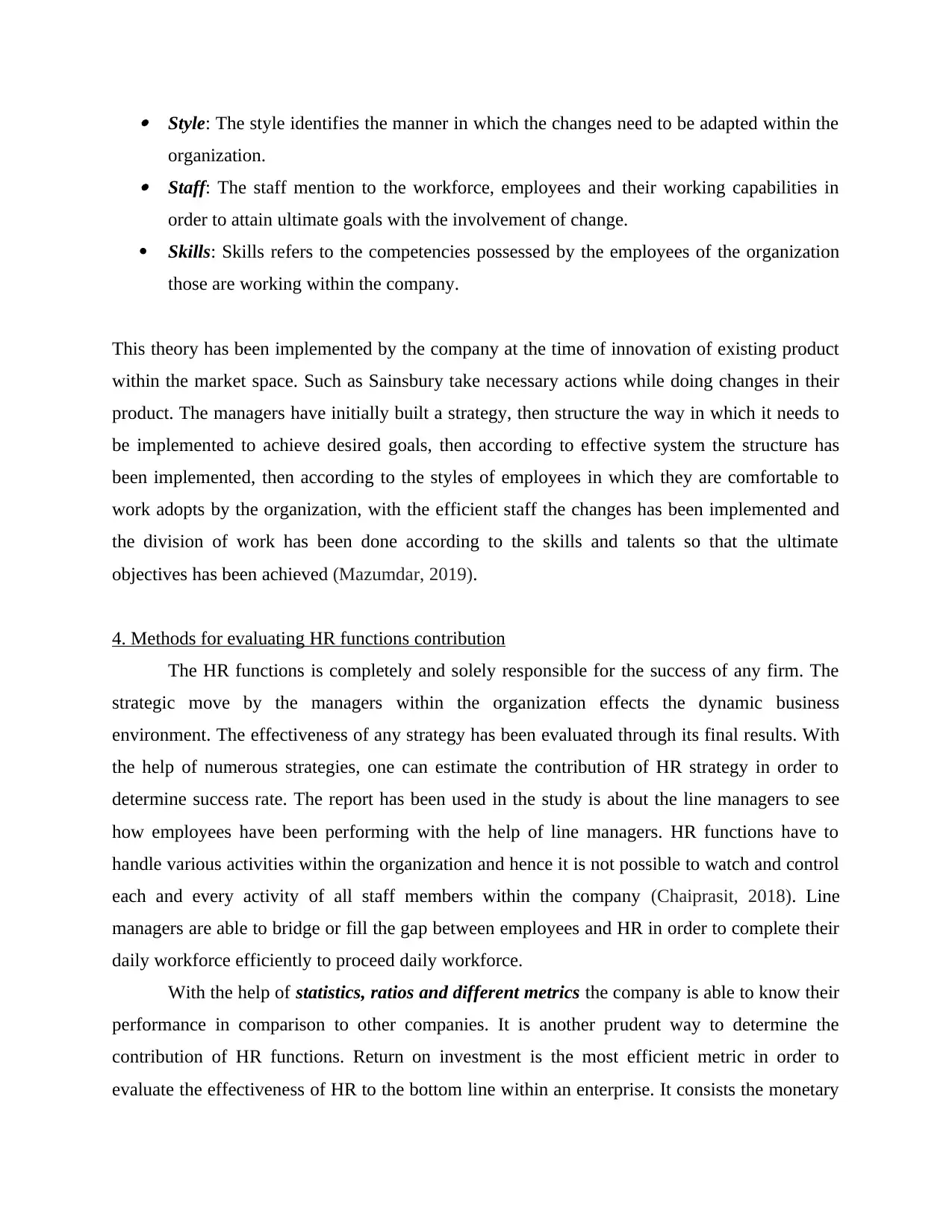
Style: The style identifies the manner in which the changes need to be adapted within the
organization. Staff: The staff mention to the workforce, employees and their working capabilities in
order to attain ultimate goals with the involvement of change.
Skills: Skills refers to the competencies possessed by the employees of the organization
those are working within the company.
This theory has been implemented by the company at the time of innovation of existing product
within the market space. Such as Sainsbury take necessary actions while doing changes in their
product. The managers have initially built a strategy, then structure the way in which it needs to
be implemented to achieve desired goals, then according to effective system the structure has
been implemented, then according to the styles of employees in which they are comfortable to
work adopts by the organization, with the efficient staff the changes has been implemented and
the division of work has been done according to the skills and talents so that the ultimate
objectives has been achieved (Mazumdar, 2019).
4. Methods for evaluating HR functions contribution
The HR functions is completely and solely responsible for the success of any firm. The
strategic move by the managers within the organization effects the dynamic business
environment. The effectiveness of any strategy has been evaluated through its final results. With
the help of numerous strategies, one can estimate the contribution of HR strategy in order to
determine success rate. The report has been used in the study is about the line managers to see
how employees have been performing with the help of line managers. HR functions have to
handle various activities within the organization and hence it is not possible to watch and control
each and every activity of all staff members within the company (Chaiprasit, 2018). Line
managers are able to bridge or fill the gap between employees and HR in order to complete their
daily workforce efficiently to proceed daily workforce.
With the help of statistics, ratios and different metrics the company is able to know their
performance in comparison to other companies. It is another prudent way to determine the
contribution of HR functions. Return on investment is the most efficient metric in order to
evaluate the effectiveness of HR to the bottom line within an enterprise. It consists the monetary
organization. Staff: The staff mention to the workforce, employees and their working capabilities in
order to attain ultimate goals with the involvement of change.
Skills: Skills refers to the competencies possessed by the employees of the organization
those are working within the company.
This theory has been implemented by the company at the time of innovation of existing product
within the market space. Such as Sainsbury take necessary actions while doing changes in their
product. The managers have initially built a strategy, then structure the way in which it needs to
be implemented to achieve desired goals, then according to effective system the structure has
been implemented, then according to the styles of employees in which they are comfortable to
work adopts by the organization, with the efficient staff the changes has been implemented and
the division of work has been done according to the skills and talents so that the ultimate
objectives has been achieved (Mazumdar, 2019).
4. Methods for evaluating HR functions contribution
The HR functions is completely and solely responsible for the success of any firm. The
strategic move by the managers within the organization effects the dynamic business
environment. The effectiveness of any strategy has been evaluated through its final results. With
the help of numerous strategies, one can estimate the contribution of HR strategy in order to
determine success rate. The report has been used in the study is about the line managers to see
how employees have been performing with the help of line managers. HR functions have to
handle various activities within the organization and hence it is not possible to watch and control
each and every activity of all staff members within the company (Chaiprasit, 2018). Line
managers are able to bridge or fill the gap between employees and HR in order to complete their
daily workforce efficiently to proceed daily workforce.
With the help of statistics, ratios and different metrics the company is able to know their
performance in comparison to other companies. It is another prudent way to determine the
contribution of HR functions. Return on investment is the most efficient metric in order to
evaluate the effectiveness of HR to the bottom line within an enterprise. It consists the monetary
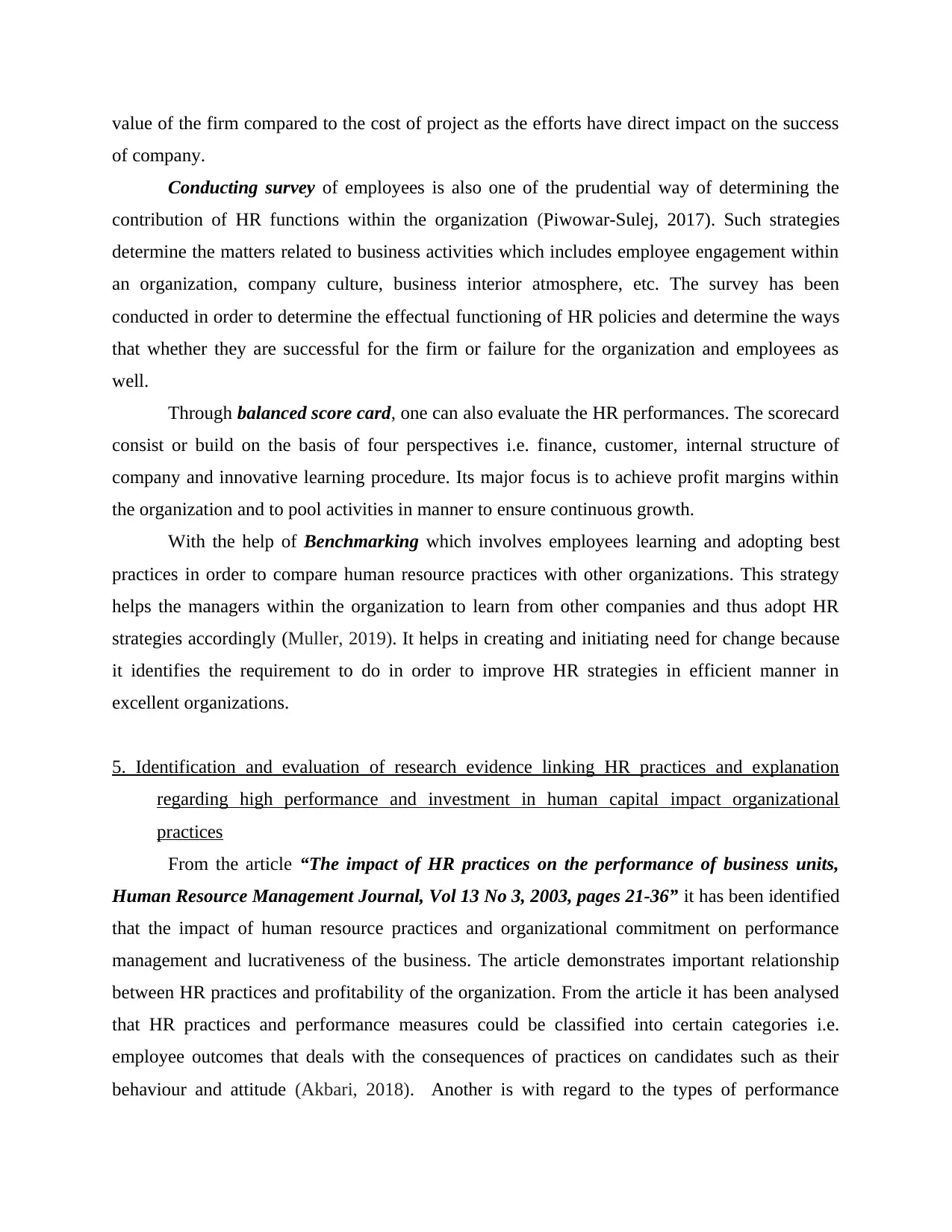
value of the firm compared to the cost of project as the efforts have direct impact on the success
of company.
Conducting survey of employees is also one of the prudential way of determining the
contribution of HR functions within the organization (Piwowar-Sulej, 2017). Such strategies
determine the matters related to business activities which includes employee engagement within
an organization, company culture, business interior atmosphere, etc. The survey has been
conducted in order to determine the effectual functioning of HR policies and determine the ways
that whether they are successful for the firm or failure for the organization and employees as
well.
Through balanced score card, one can also evaluate the HR performances. The scorecard
consist or build on the basis of four perspectives i.e. finance, customer, internal structure of
company and innovative learning procedure. Its major focus is to achieve profit margins within
the organization and to pool activities in manner to ensure continuous growth.
With the help of Benchmarking which involves employees learning and adopting best
practices in order to compare human resource practices with other organizations. This strategy
helps the managers within the organization to learn from other companies and thus adopt HR
strategies accordingly (Muller, 2019). It helps in creating and initiating need for change because
it identifies the requirement to do in order to improve HR strategies in efficient manner in
excellent organizations.
5. Identification and evaluation of research evidence linking HR practices and explanation
regarding high performance and investment in human capital impact organizational
practices
From the article “The impact of HR practices on the performance of business units,
Human Resource Management Journal, Vol 13 No 3, 2003, pages 21-36” it has been identified
that the impact of human resource practices and organizational commitment on performance
management and lucrativeness of the business. The article demonstrates important relationship
between HR practices and profitability of the organization. From the article it has been analysed
that HR practices and performance measures could be classified into certain categories i.e.
employee outcomes that deals with the consequences of practices on candidates such as their
behaviour and attitude (Akbari, 2018). Another is with regard to the types of performance
of company.
Conducting survey of employees is also one of the prudential way of determining the
contribution of HR functions within the organization (Piwowar-Sulej, 2017). Such strategies
determine the matters related to business activities which includes employee engagement within
an organization, company culture, business interior atmosphere, etc. The survey has been
conducted in order to determine the effectual functioning of HR policies and determine the ways
that whether they are successful for the firm or failure for the organization and employees as
well.
Through balanced score card, one can also evaluate the HR performances. The scorecard
consist or build on the basis of four perspectives i.e. finance, customer, internal structure of
company and innovative learning procedure. Its major focus is to achieve profit margins within
the organization and to pool activities in manner to ensure continuous growth.
With the help of Benchmarking which involves employees learning and adopting best
practices in order to compare human resource practices with other organizations. This strategy
helps the managers within the organization to learn from other companies and thus adopt HR
strategies accordingly (Muller, 2019). It helps in creating and initiating need for change because
it identifies the requirement to do in order to improve HR strategies in efficient manner in
excellent organizations.
5. Identification and evaluation of research evidence linking HR practices and explanation
regarding high performance and investment in human capital impact organizational
practices
From the article “The impact of HR practices on the performance of business units,
Human Resource Management Journal, Vol 13 No 3, 2003, pages 21-36” it has been identified
that the impact of human resource practices and organizational commitment on performance
management and lucrativeness of the business. The article demonstrates important relationship
between HR practices and profitability of the organization. From the article it has been analysed
that HR practices and performance measures could be classified into certain categories i.e.
employee outcomes that deals with the consequences of practices on candidates such as their
behaviour and attitude (Akbari, 2018). Another is with regard to the types of performance
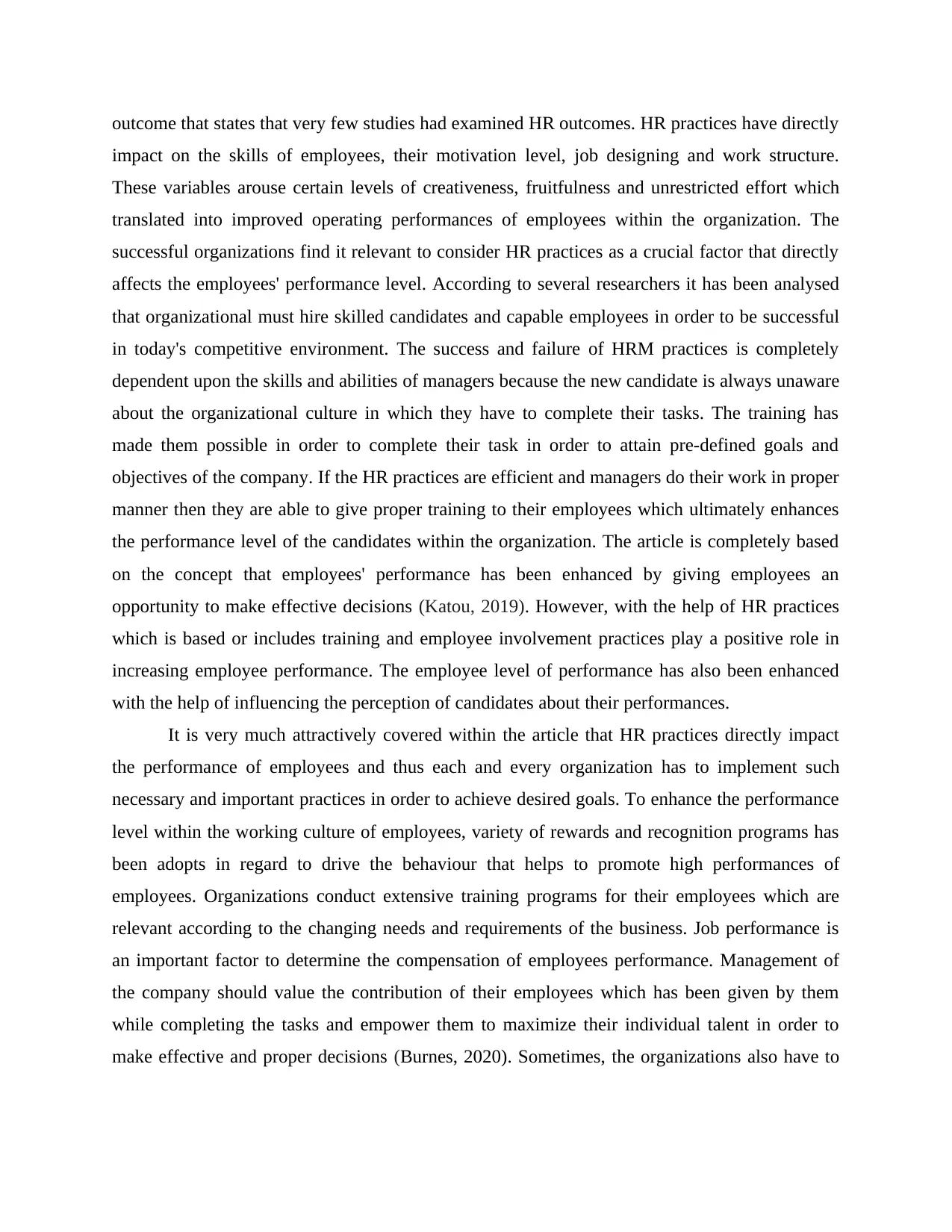
outcome that states that very few studies had examined HR outcomes. HR practices have directly
impact on the skills of employees, their motivation level, job designing and work structure.
These variables arouse certain levels of creativeness, fruitfulness and unrestricted effort which
translated into improved operating performances of employees within the organization. The
successful organizations find it relevant to consider HR practices as a crucial factor that directly
affects the employees' performance level. According to several researchers it has been analysed
that organizational must hire skilled candidates and capable employees in order to be successful
in today's competitive environment. The success and failure of HRM practices is completely
dependent upon the skills and abilities of managers because the new candidate is always unaware
about the organizational culture in which they have to complete their tasks. The training has
made them possible in order to complete their task in order to attain pre-defined goals and
objectives of the company. If the HR practices are efficient and managers do their work in proper
manner then they are able to give proper training to their employees which ultimately enhances
the performance level of the candidates within the organization. The article is completely based
on the concept that employees' performance has been enhanced by giving employees an
opportunity to make effective decisions (Katou, 2019). However, with the help of HR practices
which is based or includes training and employee involvement practices play a positive role in
increasing employee performance. The employee level of performance has also been enhanced
with the help of influencing the perception of candidates about their performances.
It is very much attractively covered within the article that HR practices directly impact
the performance of employees and thus each and every organization has to implement such
necessary and important practices in order to achieve desired goals. To enhance the performance
level within the working culture of employees, variety of rewards and recognition programs has
been adopts in regard to drive the behaviour that helps to promote high performances of
employees. Organizations conduct extensive training programs for their employees which are
relevant according to the changing needs and requirements of the business. Job performance is
an important factor to determine the compensation of employees performance. Management of
the company should value the contribution of their employees which has been given by them
while completing the tasks and empower them to maximize their individual talent in order to
make effective and proper decisions (Burnes, 2020). Sometimes, the organizations also have to
impact on the skills of employees, their motivation level, job designing and work structure.
These variables arouse certain levels of creativeness, fruitfulness and unrestricted effort which
translated into improved operating performances of employees within the organization. The
successful organizations find it relevant to consider HR practices as a crucial factor that directly
affects the employees' performance level. According to several researchers it has been analysed
that organizational must hire skilled candidates and capable employees in order to be successful
in today's competitive environment. The success and failure of HRM practices is completely
dependent upon the skills and abilities of managers because the new candidate is always unaware
about the organizational culture in which they have to complete their tasks. The training has
made them possible in order to complete their task in order to attain pre-defined goals and
objectives of the company. If the HR practices are efficient and managers do their work in proper
manner then they are able to give proper training to their employees which ultimately enhances
the performance level of the candidates within the organization. The article is completely based
on the concept that employees' performance has been enhanced by giving employees an
opportunity to make effective decisions (Katou, 2019). However, with the help of HR practices
which is based or includes training and employee involvement practices play a positive role in
increasing employee performance. The employee level of performance has also been enhanced
with the help of influencing the perception of candidates about their performances.
It is very much attractively covered within the article that HR practices directly impact
the performance of employees and thus each and every organization has to implement such
necessary and important practices in order to achieve desired goals. To enhance the performance
level within the working culture of employees, variety of rewards and recognition programs has
been adopts in regard to drive the behaviour that helps to promote high performances of
employees. Organizations conduct extensive training programs for their employees which are
relevant according to the changing needs and requirements of the business. Job performance is
an important factor to determine the compensation of employees performance. Management of
the company should value the contribution of their employees which has been given by them
while completing the tasks and empower them to maximize their individual talent in order to
make effective and proper decisions (Burnes, 2020). Sometimes, the organizations also have to
Paraphrase This Document
Need a fresh take? Get an instant paraphrase of this document with our AI Paraphraser
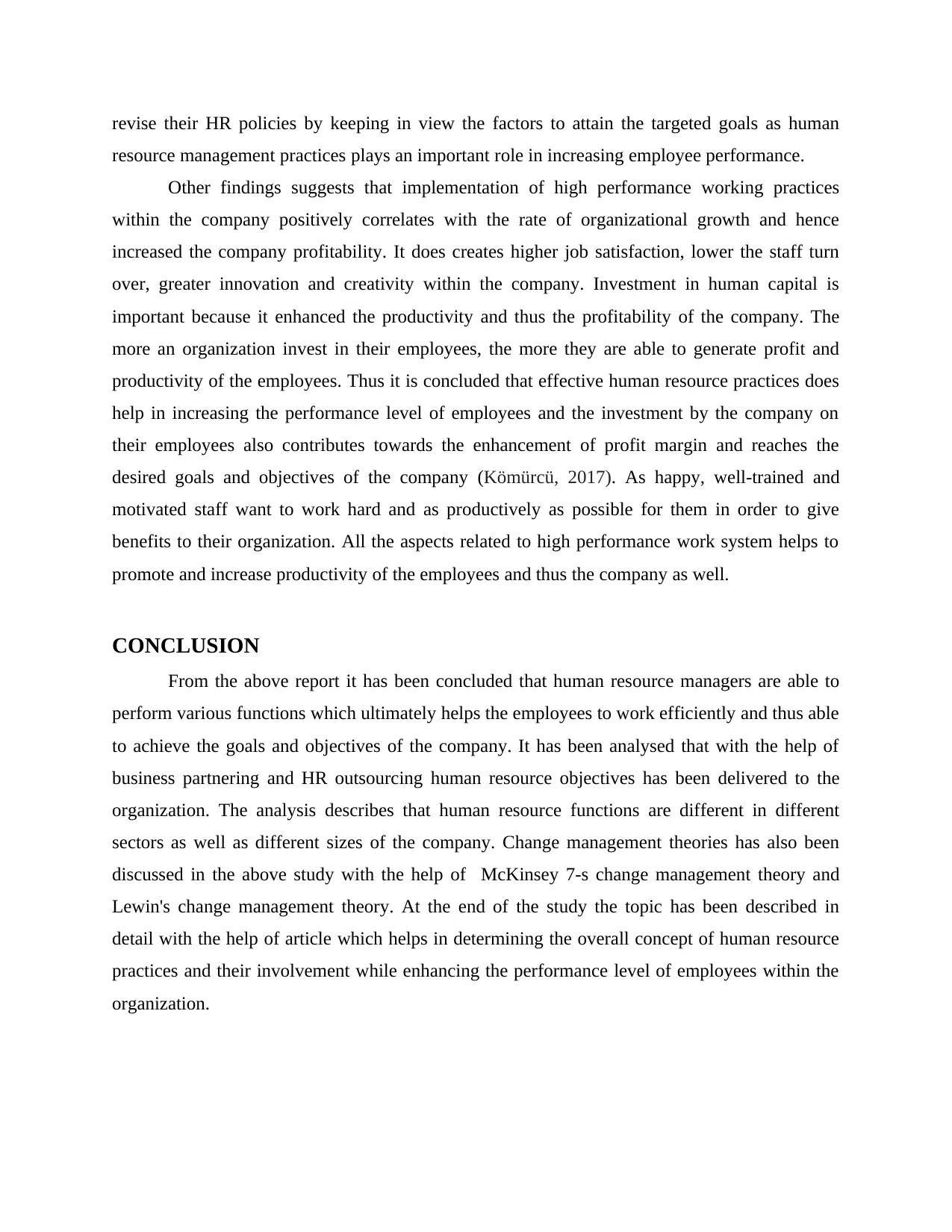
revise their HR policies by keeping in view the factors to attain the targeted goals as human
resource management practices plays an important role in increasing employee performance.
Other findings suggests that implementation of high performance working practices
within the company positively correlates with the rate of organizational growth and hence
increased the company profitability. It does creates higher job satisfaction, lower the staff turn
over, greater innovation and creativity within the company. Investment in human capital is
important because it enhanced the productivity and thus the profitability of the company. The
more an organization invest in their employees, the more they are able to generate profit and
productivity of the employees. Thus it is concluded that effective human resource practices does
help in increasing the performance level of employees and the investment by the company on
their employees also contributes towards the enhancement of profit margin and reaches the
desired goals and objectives of the company (Kömürcü, 2017). As happy, well-trained and
motivated staff want to work hard and as productively as possible for them in order to give
benefits to their organization. All the aspects related to high performance work system helps to
promote and increase productivity of the employees and thus the company as well.
CONCLUSION
From the above report it has been concluded that human resource managers are able to
perform various functions which ultimately helps the employees to work efficiently and thus able
to achieve the goals and objectives of the company. It has been analysed that with the help of
business partnering and HR outsourcing human resource objectives has been delivered to the
organization. The analysis describes that human resource functions are different in different
sectors as well as different sizes of the company. Change management theories has also been
discussed in the above study with the help of McKinsey 7-s change management theory and
Lewin's change management theory. At the end of the study the topic has been described in
detail with the help of article which helps in determining the overall concept of human resource
practices and their involvement while enhancing the performance level of employees within the
organization.
resource management practices plays an important role in increasing employee performance.
Other findings suggests that implementation of high performance working practices
within the company positively correlates with the rate of organizational growth and hence
increased the company profitability. It does creates higher job satisfaction, lower the staff turn
over, greater innovation and creativity within the company. Investment in human capital is
important because it enhanced the productivity and thus the profitability of the company. The
more an organization invest in their employees, the more they are able to generate profit and
productivity of the employees. Thus it is concluded that effective human resource practices does
help in increasing the performance level of employees and the investment by the company on
their employees also contributes towards the enhancement of profit margin and reaches the
desired goals and objectives of the company (Kömürcü, 2017). As happy, well-trained and
motivated staff want to work hard and as productively as possible for them in order to give
benefits to their organization. All the aspects related to high performance work system helps to
promote and increase productivity of the employees and thus the company as well.
CONCLUSION
From the above report it has been concluded that human resource managers are able to
perform various functions which ultimately helps the employees to work efficiently and thus able
to achieve the goals and objectives of the company. It has been analysed that with the help of
business partnering and HR outsourcing human resource objectives has been delivered to the
organization. The analysis describes that human resource functions are different in different
sectors as well as different sizes of the company. Change management theories has also been
discussed in the above study with the help of McKinsey 7-s change management theory and
Lewin's change management theory. At the end of the study the topic has been described in
detail with the help of article which helps in determining the overall concept of human resource
practices and their involvement while enhancing the performance level of employees within the
organization.
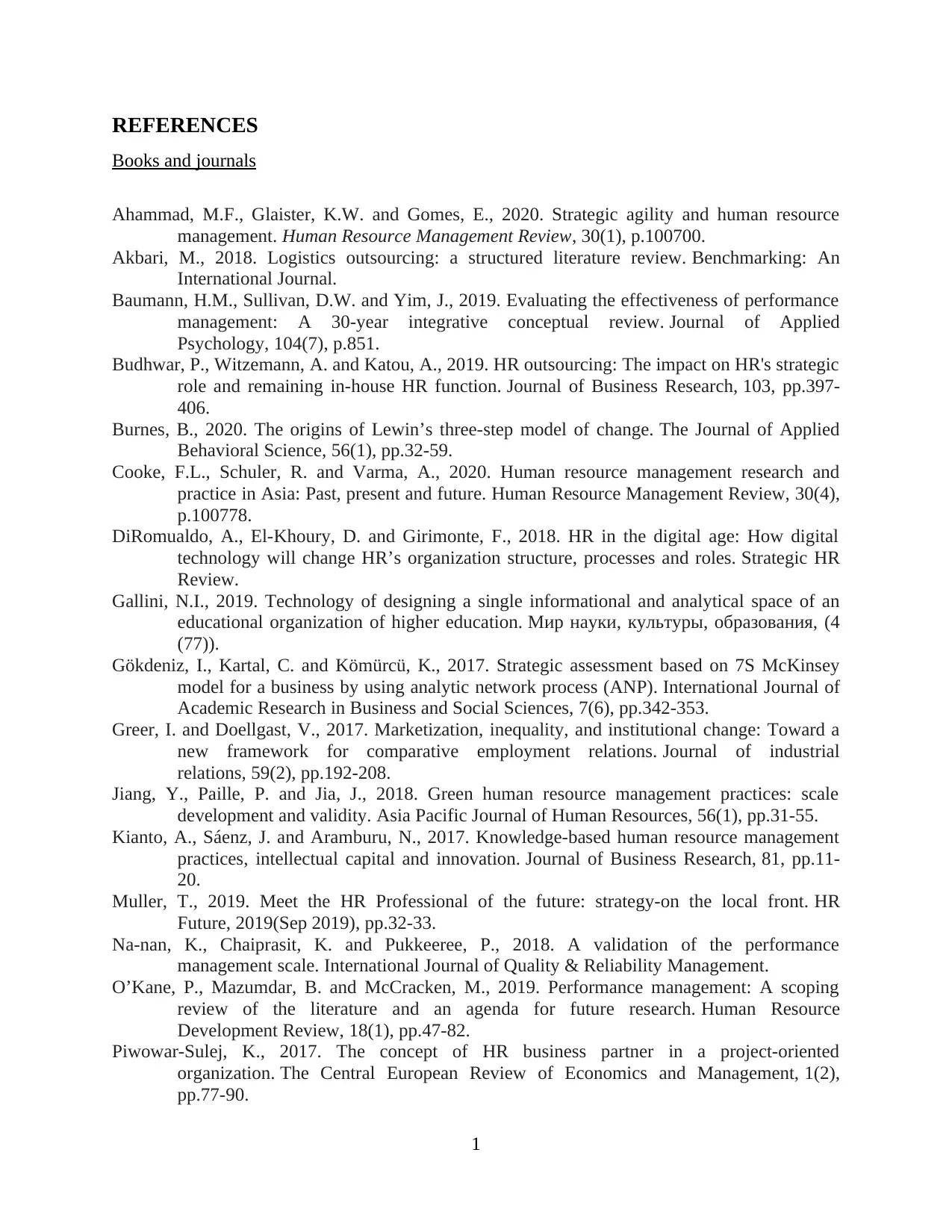
REFERENCES
Books and journals
Ahammad, M.F., Glaister, K.W. and Gomes, E., 2020. Strategic agility and human resource
management. Human Resource Management Review, 30(1), p.100700.
Akbari, M., 2018. Logistics outsourcing: a structured literature review. Benchmarking: An
International Journal.
Baumann, H.M., Sullivan, D.W. and Yim, J., 2019. Evaluating the effectiveness of performance
management: A 30-year integrative conceptual review. Journal of Applied
Psychology, 104(7), p.851.
Budhwar, P., Witzemann, A. and Katou, A., 2019. HR outsourcing: The impact on HR's strategic
role and remaining in-house HR function. Journal of Business Research, 103, pp.397-
406.
Burnes, B., 2020. The origins of Lewin’s three-step model of change. The Journal of Applied
Behavioral Science, 56(1), pp.32-59.
Cooke, F.L., Schuler, R. and Varma, A., 2020. Human resource management research and
practice in Asia: Past, present and future. Human Resource Management Review, 30(4),
p.100778.
DiRomualdo, A., El-Khoury, D. and Girimonte, F., 2018. HR in the digital age: How digital
technology will change HR’s organization structure, processes and roles. Strategic HR
Review.
Gallini, N.I., 2019. Technology of designing a single informational and analytical space of an
educational organization of higher education. Мир науки, культуры, образования, (4
(77)).
Gökdeniz, I., Kartal, C. and Kömürcü, K., 2017. Strategic assessment based on 7S McKinsey
model for a business by using analytic network process (ANP). International Journal of
Academic Research in Business and Social Sciences, 7(6), pp.342-353.
Greer, I. and Doellgast, V., 2017. Marketization, inequality, and institutional change: Toward a
new framework for comparative employment relations. Journal of industrial
relations, 59(2), pp.192-208.
Jiang, Y., Paille, P. and Jia, J., 2018. Green human resource management practices: scale
development and validity. Asia Pacific Journal of Human Resources, 56(1), pp.31-55.
Kianto, A., Sáenz, J. and Aramburu, N., 2017. Knowledge-based human resource management
practices, intellectual capital and innovation. Journal of Business Research, 81, pp.11-
20.
Muller, T., 2019. Meet the HR Professional of the future: strategy-on the local front. HR
Future, 2019(Sep 2019), pp.32-33.
Na-nan, K., Chaiprasit, K. and Pukkeeree, P., 2018. A validation of the performance
management scale. International Journal of Quality & Reliability Management.
O’Kane, P., Mazumdar, B. and McCracken, M., 2019. Performance management: A scoping
review of the literature and an agenda for future research. Human Resource
Development Review, 18(1), pp.47-82.
Piwowar-Sulej, K., 2017. The concept of HR business partner in a project-oriented
organization. The Central European Review of Economics and Management, 1(2),
pp.77-90.
1
Books and journals
Ahammad, M.F., Glaister, K.W. and Gomes, E., 2020. Strategic agility and human resource
management. Human Resource Management Review, 30(1), p.100700.
Akbari, M., 2018. Logistics outsourcing: a structured literature review. Benchmarking: An
International Journal.
Baumann, H.M., Sullivan, D.W. and Yim, J., 2019. Evaluating the effectiveness of performance
management: A 30-year integrative conceptual review. Journal of Applied
Psychology, 104(7), p.851.
Budhwar, P., Witzemann, A. and Katou, A., 2019. HR outsourcing: The impact on HR's strategic
role and remaining in-house HR function. Journal of Business Research, 103, pp.397-
406.
Burnes, B., 2020. The origins of Lewin’s three-step model of change. The Journal of Applied
Behavioral Science, 56(1), pp.32-59.
Cooke, F.L., Schuler, R. and Varma, A., 2020. Human resource management research and
practice in Asia: Past, present and future. Human Resource Management Review, 30(4),
p.100778.
DiRomualdo, A., El-Khoury, D. and Girimonte, F., 2018. HR in the digital age: How digital
technology will change HR’s organization structure, processes and roles. Strategic HR
Review.
Gallini, N.I., 2019. Technology of designing a single informational and analytical space of an
educational organization of higher education. Мир науки, культуры, образования, (4
(77)).
Gökdeniz, I., Kartal, C. and Kömürcü, K., 2017. Strategic assessment based on 7S McKinsey
model for a business by using analytic network process (ANP). International Journal of
Academic Research in Business and Social Sciences, 7(6), pp.342-353.
Greer, I. and Doellgast, V., 2017. Marketization, inequality, and institutional change: Toward a
new framework for comparative employment relations. Journal of industrial
relations, 59(2), pp.192-208.
Jiang, Y., Paille, P. and Jia, J., 2018. Green human resource management practices: scale
development and validity. Asia Pacific Journal of Human Resources, 56(1), pp.31-55.
Kianto, A., Sáenz, J. and Aramburu, N., 2017. Knowledge-based human resource management
practices, intellectual capital and innovation. Journal of Business Research, 81, pp.11-
20.
Muller, T., 2019. Meet the HR Professional of the future: strategy-on the local front. HR
Future, 2019(Sep 2019), pp.32-33.
Na-nan, K., Chaiprasit, K. and Pukkeeree, P., 2018. A validation of the performance
management scale. International Journal of Quality & Reliability Management.
O’Kane, P., Mazumdar, B. and McCracken, M., 2019. Performance management: A scoping
review of the literature and an agenda for future research. Human Resource
Development Review, 18(1), pp.47-82.
Piwowar-Sulej, K., 2017. The concept of HR business partner in a project-oriented
organization. The Central European Review of Economics and Management, 1(2),
pp.77-90.
1
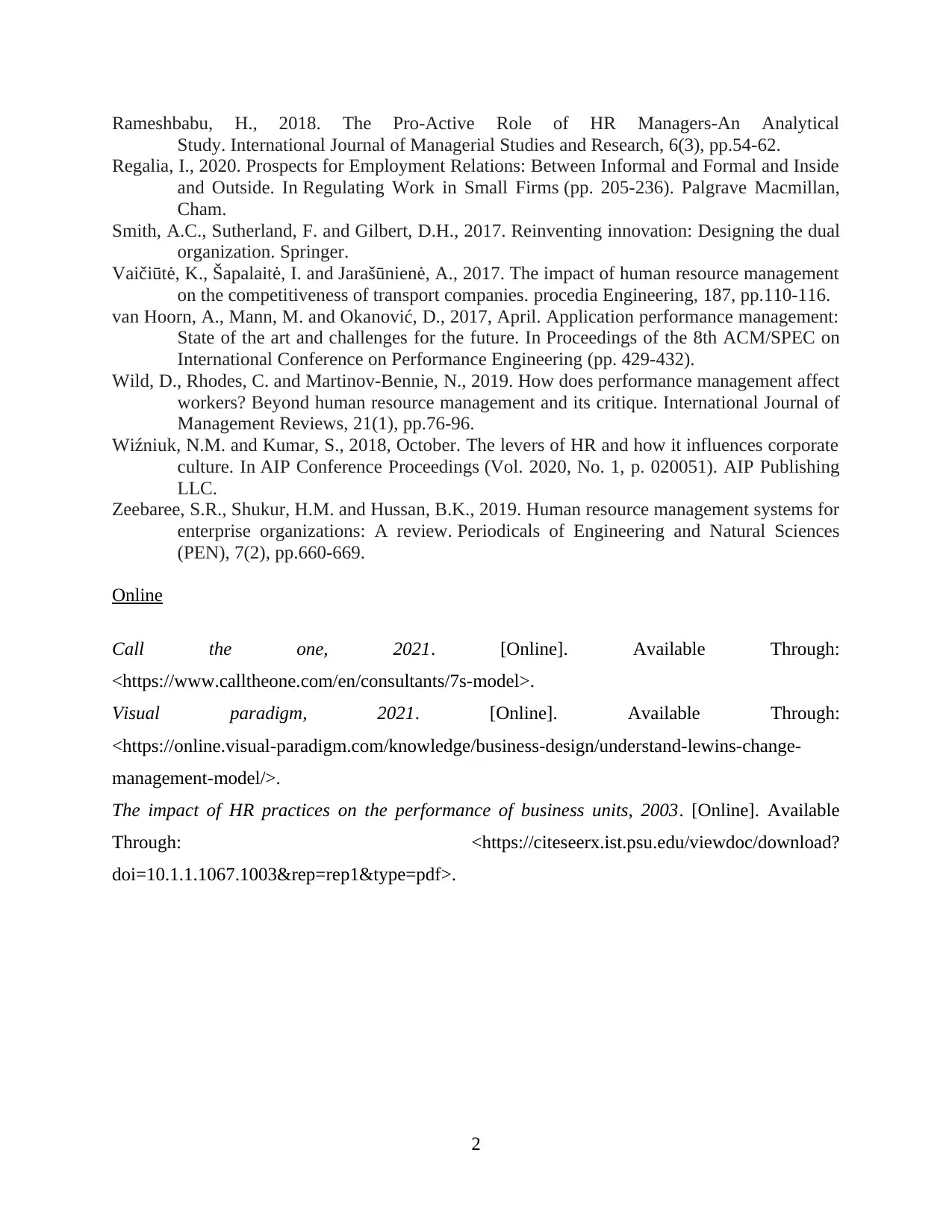
Rameshbabu, H., 2018. The Pro-Active Role of HR Managers-An Analytical
Study. International Journal of Managerial Studies and Research, 6(3), pp.54-62.
Regalia, I., 2020. Prospects for Employment Relations: Between Informal and Formal and Inside
and Outside. In Regulating Work in Small Firms (pp. 205-236). Palgrave Macmillan,
Cham.
Smith, A.C., Sutherland, F. and Gilbert, D.H., 2017. Reinventing innovation: Designing the dual
organization. Springer.
Vaičiūtė, K., Šapalaitė, I. and Jarašūnienė, A., 2017. The impact of human resource management
on the competitiveness of transport companies. procedia Engineering, 187, pp.110-116.
van Hoorn, A., Mann, M. and Okanović, D., 2017, April. Application performance management:
State of the art and challenges for the future. In Proceedings of the 8th ACM/SPEC on
International Conference on Performance Engineering (pp. 429-432).
Wild, D., Rhodes, C. and Martinov‐Bennie, N., 2019. How does performance management affect
workers? Beyond human resource management and its critique. International Journal of
Management Reviews, 21(1), pp.76-96.
Wiźniuk, N.M. and Kumar, S., 2018, October. The levers of HR and how it influences corporate
culture. In AIP Conference Proceedings (Vol. 2020, No. 1, p. 020051). AIP Publishing
LLC.
Zeebaree, S.R., Shukur, H.M. and Hussan, B.K., 2019. Human resource management systems for
enterprise organizations: A review. Periodicals of Engineering and Natural Sciences
(PEN), 7(2), pp.660-669.
Online
Call the one, 2021. [Online]. Available Through:
<https://www.calltheone.com/en/consultants/7s-model>.
Visual paradigm, 2021. [Online]. Available Through:
<https://online.visual-paradigm.com/knowledge/business-design/understand-lewins-change-
management-model/>.
The impact of HR practices on the performance of business units, 2003. [Online]. Available
Through: <https://citeseerx.ist.psu.edu/viewdoc/download?
doi=10.1.1.1067.1003&rep=rep1&type=pdf>.
2
Study. International Journal of Managerial Studies and Research, 6(3), pp.54-62.
Regalia, I., 2020. Prospects for Employment Relations: Between Informal and Formal and Inside
and Outside. In Regulating Work in Small Firms (pp. 205-236). Palgrave Macmillan,
Cham.
Smith, A.C., Sutherland, F. and Gilbert, D.H., 2017. Reinventing innovation: Designing the dual
organization. Springer.
Vaičiūtė, K., Šapalaitė, I. and Jarašūnienė, A., 2017. The impact of human resource management
on the competitiveness of transport companies. procedia Engineering, 187, pp.110-116.
van Hoorn, A., Mann, M. and Okanović, D., 2017, April. Application performance management:
State of the art and challenges for the future. In Proceedings of the 8th ACM/SPEC on
International Conference on Performance Engineering (pp. 429-432).
Wild, D., Rhodes, C. and Martinov‐Bennie, N., 2019. How does performance management affect
workers? Beyond human resource management and its critique. International Journal of
Management Reviews, 21(1), pp.76-96.
Wiźniuk, N.M. and Kumar, S., 2018, October. The levers of HR and how it influences corporate
culture. In AIP Conference Proceedings (Vol. 2020, No. 1, p. 020051). AIP Publishing
LLC.
Zeebaree, S.R., Shukur, H.M. and Hussan, B.K., 2019. Human resource management systems for
enterprise organizations: A review. Periodicals of Engineering and Natural Sciences
(PEN), 7(2), pp.660-669.
Online
Call the one, 2021. [Online]. Available Through:
<https://www.calltheone.com/en/consultants/7s-model>.
Visual paradigm, 2021. [Online]. Available Through:
<https://online.visual-paradigm.com/knowledge/business-design/understand-lewins-change-
management-model/>.
The impact of HR practices on the performance of business units, 2003. [Online]. Available
Through: <https://citeseerx.ist.psu.edu/viewdoc/download?
doi=10.1.1.1067.1003&rep=rep1&type=pdf>.
2
Secure Best Marks with AI Grader
Need help grading? Try our AI Grader for instant feedback on your assignments.

3
1 out of 17
Related Documents
Your All-in-One AI-Powered Toolkit for Academic Success.
+13062052269
info@desklib.com
Available 24*7 on WhatsApp / Email
![[object Object]](/_next/static/media/star-bottom.7253800d.svg)
Unlock your academic potential
© 2024 | Zucol Services PVT LTD | All rights reserved.





